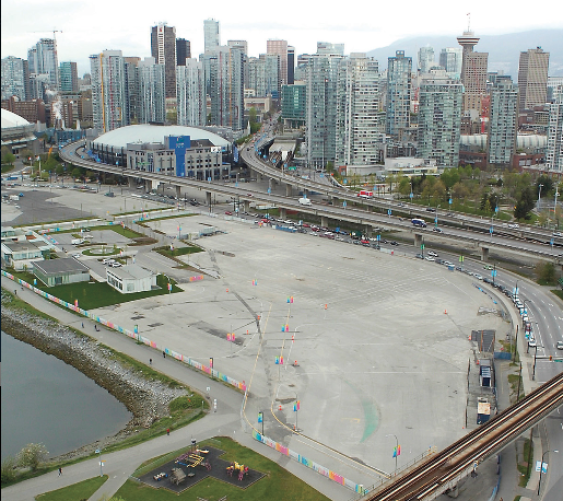After two years of studying whether the Georgia and Dunsmuir viaducts should remain standing or be flattened, city staff has reached a decision on the future of the elevated roadways: Knock the suckers down.
Kevin McNaney, the city’s assistant director of planning, said a report will be presented to city council in September that recommends the 1970s-era hulking structures that connect Chinatown to downtown should be demolished and replaced by a new road network.
“We’ve really done the detailed work and sunk our teeth into the transportation network, and it shows that it’s actually a better transportation system,” said McNaney, noting the new network would link Georgia Street to Pacific in a sloping grade.
With 43,000 vehicles per day using the viaducts, city staff completed what McNaney described as “extensive transportation modeling”— studying turns, signal systems and where the traffic originates -- to ensure traffic chaos wouldn’t ensue without the elevated roadways.
The other factor that swayed staff to demolish the viaducts was the expensive work required to keep the structures seismically sound. McNaney said it would cost up to $65 million “just to keep them standing” in an earthquake.
“It doesn’t mean that they would be usable after, which is obviously a huge concern,” he said, noting the viaducts could topple over on top of the SkyTrain and cut off downtown from the new St. Paul’s Hospital proposed for the False Creek Flats. “We need that post-disaster transportation system from downtown to get people to the hospital.”
As for fears Strathcona residents had early on about their neighbourhood being overrun with vehicles, McNaney said planning staff concluded traffic volumes will decrease on Prior Street. He noted staff is also looking at an alternative roadway to Prior which could mean a new connector across the False Creek Flats, potentially on Malkin or National. Those ideas are being discussed as part of the area plan for the False Creek Flats.
Taking the viaducts down should trigger the completion of development in Northeast False Creek, including building the much-awaited Creekside park to the north of the Telus World of Science. That project has been delayed for two decades as Concord Pacific looks to develop its final pieces of properties on the former Expo 86 lands.
McNaney said negotiations continue with Concord to determine land transfers and swaps to ensure the new roadway could be built in the area that the viaducts now occupy. City staff’s plan calls for the SkyTrain track to remain.
Whatever gets done, it will be expensive.
A staff report to city council in June 2013 said it would cost up to $55 million to demolish the viaducts. The tab for such a project climbs to more than $130 million when costs are calculated to modify existing streets, parks, utilities, build more parks and conduct soil remediation on what were former industrial lands.
The same report said demolishing the viaducts would free up 10 acres of land worth up to $110 million. Although staff’s desire is to have the land devoted for public open space, affordable housing and other public uses, the report notes some of the land could be sold for development.
NPA Coun. George Affleck said he will wait to see the final report in September before stating whether he agrees with staff’s recommendation to demolish the viaducts. Affleck said he is concerned removing the viaducts would have a negative effect on traffic flow in the area. He also has questions about the tab for the project, which he believes should be “cost-neutral.”
“It could be a design improvement for our city but I also understand how people are feeling about getting around,” Affleck said of knocking down the viaducts.
If the viaducts are demolished, Affleck said, city staff should clearly spell out that any new development that may come about as a result of land that opens up in the area should be tied to paying for the cost of any deconstruction of the viaducts. Development cost levies and community amenity contributions should pay – or help pay -- for that work, he said.
“It has to be cost-neutral and I think there’s money for the city to be made from the development opportunities in that neighbourhood,” Affleck said.
Vision Coun. Geoff Meggs, who years ago proposed the city consider demolishing the viaducts, said it’s difficult to say what the final cost-benefit figures of demolishing the viaducts will be because the two blocks the city would gain on either side of Main Street would have to be rezoned.
“Obviously, we want the direct costs to be as low as possible but I don’t think we want to tie the hands of future planning decisions or make any assumptions how dense the surrounding area would be,” Meggs said. “We should go forward and make a decision about whether we want to take this bold step for the future, or not. And we should do that in September. After that, we can work through a whole bunch of these other issues. It would be crazy to try to say today that we know exactly what’s going to unfold there over 20 years.”
Meggs said he’s heard from many people who want to see affordable housing built where the viaducts’ on-and-off-ramps are located on Main Street. And if that’s done, he said, then the value of the land “would be less, but the value to the community might be more.”
Added Meggs: “I’ve always felt the opportunity was a fantastic one for building the city, and that’s what staff have been telling council for a long time now.”
@Howellings



